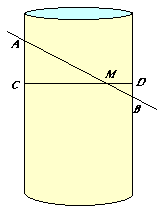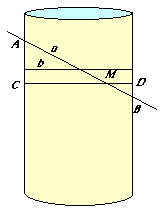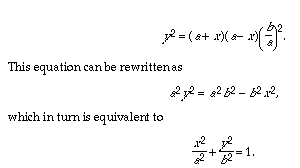Derivation of ellipse's rectangular coordinate equation
The coordinate geometry of Descartes and Fermat became popular because it could be used to describe all kinds of geometric shapes. For example, the points on a circle centered at the origin could be described by the equation x 2 + y 2 = r 2, where r is the radius of the circle.
How can coordinate geometry be used to describe an ellipse?
The first decision to be made in finding an equation for a figure is where to put the origin. The symmetry of the ellipse would indicate that the equation would be simpler if the origin were at the ellipse's center, so let's begin with that; but let's not forget that the foci are sometimes easier to work with than the center and be ready to switch the origin if needed.
What do we know about ellipses that we might use in developing an equation? So far we have derived several properties: the cylindrical section property, the constant sum property, the conic section property, and the constant ratio property. Because the cylindrical section property was our definition, let's see if it can lead easily to an equation.
This reasoning might have been used by Apollonius, although he was working with a cone and had no ideas about equations.
Let's mark up a picture of an ellipse.
Our goal is to find an equation relating the lengths marked x and y. In the side view, the segment of length y comes out toward us.
The picture might remind us of a theorem about circles: that when a perpendicular like this is raised from a diameter, the square of the length of the perpendicular is the product of the lengths of the pieces into which it divides the diameter.

In the picture, y 2 = (CM )(MD ). Can we use this fact somehow in our ellipse which isn't necessarily a circle? Can we get a circle that relates closely to the ellipse?
We can imagine a circle that is formed if we pivot the ellipse about its minor axis until it's perpendicular to the cylinder's axis. The center of that circle is at the center of the ellipse. But the length y is not part of that circle. More effectively, we might extend the segment marked y to cross the ellipse and pivot along that longer segment. Then we get a circle that has the length y perpendicular to its diameter.

For this circle, as we know, we can say that y 2 = (CM )(MD ).
Can we relate the lengths AM and MB of the circle to corresponding lengths CM and MD on the original ellipse? Don't we have some similar triangles? Yes; triangles AMC and BMD are similar. So we have

If this ratio is some constant k, then the fact that y 2 = (CM )(MD ) can be translated into y 2 = (AM )(k )(MB )(k ) = (AM )(MB )k 2.
That's a pretty impressive generalization of a property of circles right there. But we're interested in applying it to finding the equation of an ellipse. Can we relate AM and MB to x ? We see that AM is the length of the semimajor axis plus x , and MB is the length of the semimajor axis minus x. That is, if the length of the semimajor axis is a, then we have
We have an equation for an ellipse!
But we really need to know what k is for our equation to be complete. Somehow we'd like to relate k to other lengths we know on the ellipse. Can we try similar triangles again? Remember the false start we made in pivoting the ellipse around the minor axis to make a circle? If we view that situation from the side,

we see that we have other triangles similar to the original ones. But what is the length of that line segment from the center to C? It's a radius of the cylinder. And the cylinder's radius is the semiminor axis of the ellipse. So it has length b. Therefore the ratio k we've been considering, equals b/a. Hence we can say













